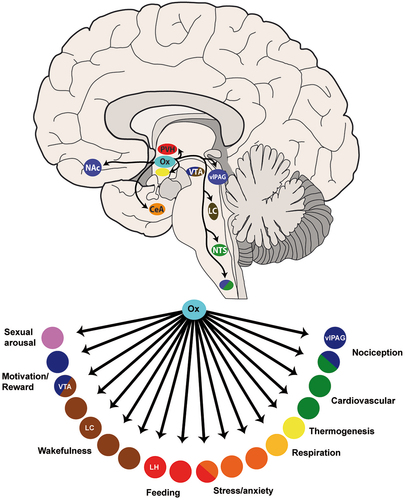Figures & data
Figure 1. Schematic representation of the orexinergic system.
The orexin system is comprised of two G-protein coupled receptors (GPCR): orexin-1 (OX1R) and orexin-2 (OX2R). Two neuropeptides: orexin-A and orexin-B, are cleaved from the precursor protein prepro-orexin. The OX1R is selective for OXA, whereas OX2R is nonselective for OXA and OXB. However, OXB has a 10-fold higher affinity for the OX2R than the OX1R. The OX1R couples to the Gq class of G protein, whereas OX2R couples with Gi or Go. Adapted with permission from PR Holland (2006) [Citation35].

Figure 2. Orexinergic projections and their proposed functions.
The orexins are almost exclusively synthesized in the lateral hypothalamus (LH) and project to many areas of the CNS including brainstem and cortical regions. The orexins are proposed to be involved in a variety of functions from reward, feeding, cognition, to nociception. LC = locus coeruleus; LH = lateral hypothalamus; vlPAG = ventrolateral periaqueductal gray; VTA = ventral tegmental area; Ox = orexin; NTS = nucleus tractus solitarii; NAc = nucleus accumbens; PVH = posterior ventral hypothalamus; CeA = central amygdala. Adapted with permission from P Sureda-Gibert [Citation55].

